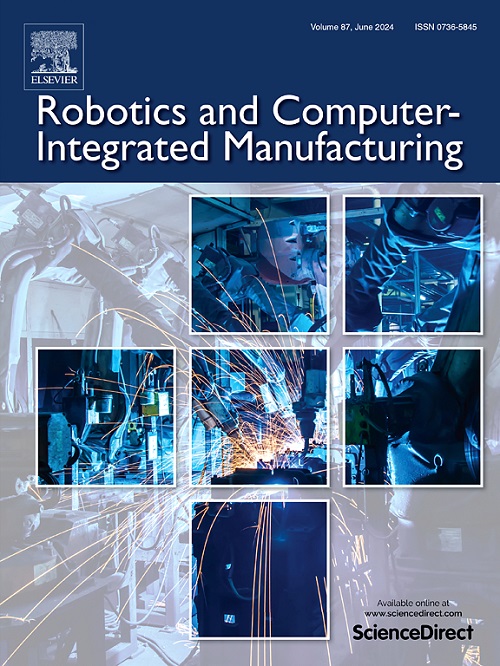Design, modelling, and implementation of a novel parallel end effector for robotic grinding
IF 11.4
1区 计算机科学
Q1 COMPUTER SCIENCE, INTERDISCIPLINARY APPLICATIONS
引用次数: 0
Abstract
Parallel mechanisms provide benefits like high stiffness and dexterity when used as robotic end effectors. This paper presents a novel redundant parallel end effector (PEE) with 3 degrees of freedom for robotic grinding of curved surfaces. The mobility, inverse kinematics, velocity analysis, workspace, motion force transmissibility and singularity of the PEE are systematically analyzed using the screw theory. The inverse dynamic model is established by combining the screw theory with the virtual work principle. Simulations are implemented to verify the accuracies of kinematics and dynamics models. An experimental platform is built and tests show the prototype can precisely track various trajectories. Grinding experiments on curved surfaces indicate significant improvement in surface quality. The experimental results verify the application potential of the designed PEE in the precision grinding of complex curved surface parts.
一种新型机器人磨削并联末端执行器的设计、建模和实现
当用作机器人末端执行器时,并联机构具有高刚度和灵活性等优点。提出了一种用于曲面机器人磨削的三自由度冗余并联末端执行器。利用螺旋理论系统地分析了机器人的运动度、运动学逆解、速度分析、工作空间、运动力传递率和奇异性。将螺旋理论与虚功原理相结合,建立了逆动力学模型。通过仿真验证了运动学和动力学模型的准确性。搭建了实验平台,实验结果表明,该样机能够精确跟踪各种轨迹。对曲面的磨削实验表明,磨削后的曲面质量有明显改善。实验结果验证了该方法在复杂曲面零件精密磨削中的应用潜力。
本文章由计算机程序翻译,如有差异,请以英文原文为准。
求助全文
约1分钟内获得全文
求助全文
来源期刊
CiteScore
24.10
自引率
13.50%
发文量
160
审稿时长
50 days
期刊介绍:
The journal, Robotics and Computer-Integrated Manufacturing, focuses on sharing research applications that contribute to the development of new or enhanced robotics, manufacturing technologies, and innovative manufacturing strategies that are relevant to industry. Papers that combine theory and experimental validation are preferred, while review papers on current robotics and manufacturing issues are also considered. However, papers on traditional machining processes, modeling and simulation, supply chain management, and resource optimization are generally not within the scope of the journal, as there are more appropriate journals for these topics. Similarly, papers that are overly theoretical or mathematical will be directed to other suitable journals. The journal welcomes original papers in areas such as industrial robotics, human-robot collaboration in manufacturing, cloud-based manufacturing, cyber-physical production systems, big data analytics in manufacturing, smart mechatronics, machine learning, adaptive and sustainable manufacturing, and other fields involving unique manufacturing technologies.

 求助内容:
求助内容: 应助结果提醒方式:
应助结果提醒方式:


